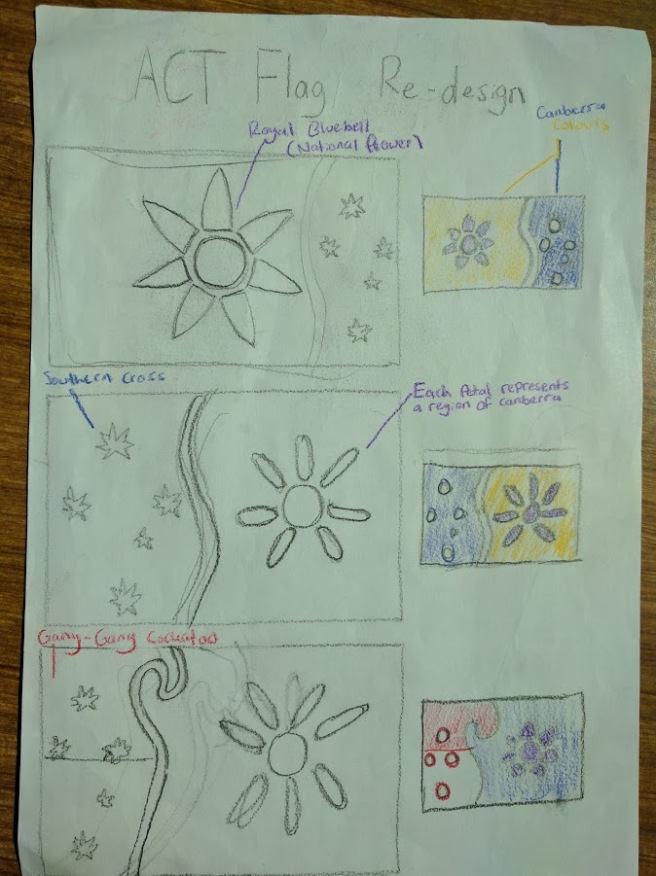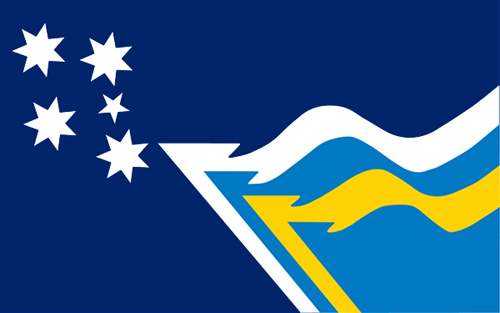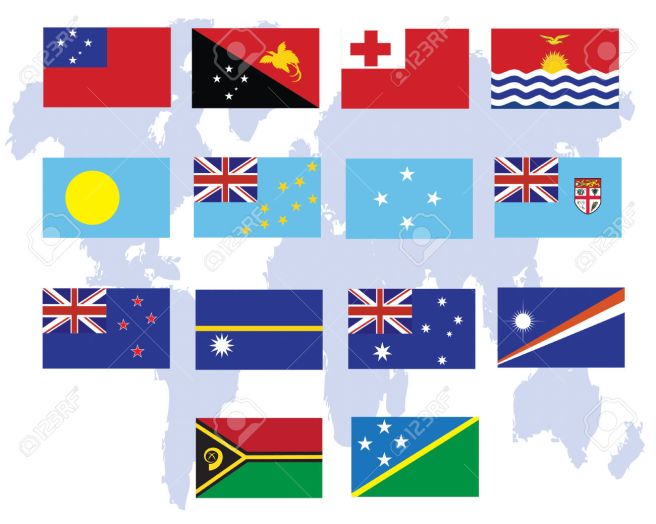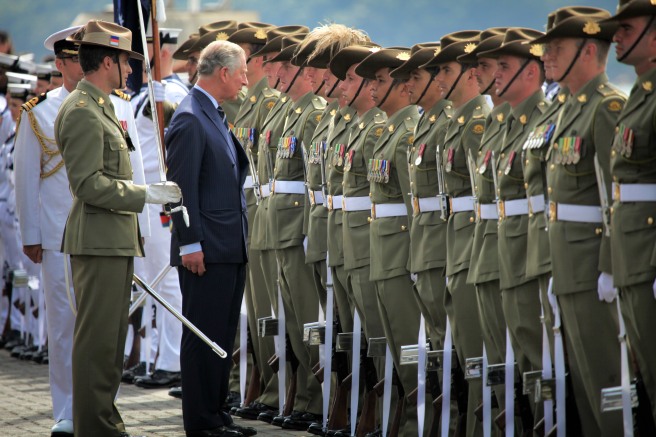After doing more research on vexillology as well as looking at different designs of flags across Australia (such as Northern Territory and Victoria), I decided to use similar concepts to create a re-design of the ACT flag. For the design, I thought it would be best to use the same colours as the original ACT flag as those colours are already identified as the colours of the ACT. One of the rules of vexillology is that the design should be simple, simple enough that a 9 year old could draw it, despite this, the current ACT flag uses a complicated coat of arms that 9 year old wouldn’t be able to draw very well. What other element could replace the coat of arms but still have the same meaning?
One of the main elements I wanted to incorporate in the design is the Canberra floral emblem (Royal Bluebell). I drew out what the flower would normally look like and then began to think of ways to simplify it so that it fits in with the basic design elements and principles. The flower has 7 petals which represents the different regions of Canberra (Tuggeranong, Woden, Weston Creek, South Canberra, North Canberra, Belconnen and Gungahlin)

What I did next was create three colour rendered sketches of my alternate ACT flag design. The first design incorporates the floral emblem, designed in a more neat and simple way as well as the regional colours of Canberra, reversed from the original design. It also incorporates the southern cross so that it remains close to the original.
The second design is very similar from the first although this design has a different depiction of the ACT floral emblem, the petals are much thinner which is suppose to symbolize aboriginal culture in respects to the Ngunnawal people. The design also keeps thee same colours and layout of the original ACT flag design.
I also wanted to create a flag design that is unique from the original colours of the current ACT flag, so in the 3rd design I incorporated new elements and colours. The design’s main feature is the red swirl on the left which represents the Gang Gang Cockatoo which is a bird that can is only found throughout the ACT. The design is a bit more groovy and still incorporates the floral emblem of the ACT.

Upon further research, I stumbled across this new video which explains the symbolism behind a newly designed Australian Flag. For my designers statement later on, I want to be able to go in depth as this video does, unpacking each element and it’s importance. I think one reason why I really admire the way the flag was unpacked was the symbolism of the yellow circle, I mentioned previously on this blog that we need a design that represents Australia as a nation that is diverse, a flag that represents all Australians and still pays respect to the custodians of Australia as well as elements from the previous flag.
So after spending a couple hours researching flag designs and flag principles, I’ve soon learnt that instead of being overly safe with my flag design, I want to create something unique and interesting, something that may technically break the 5 rules of vexillology although is still an effective design the captivates anyone who sees it. Although, there are so many alternate Australian flags out there that it will be quite a challenge to come up with something original although I found this image below which is the flag which represents the Flag Society of Australia Inc.

As soon as I laid my eyes on this flag, it immediately caught my attention and made me go “WOW!!”. The awesome thing is, it actually follows the guidelines and principles of flag design as well as design in general. The stand out feature is the depiction of a wavy flag in the bottom right, at first I actually though it was a kangaroo but its actually of a flag as well. The colours work perfectly and to be able to present a kangaroo and a flag in the same image, is quite unique and inspires me to create something similar.
Technically it disobeys the rules of vexillology because there is a flag inside a flag 😉
Here is a screen grab from the Ausflag website of different Australian flag designs! From researching alternate flag designs in general, I’ve come to see the different elements some people have considered. There are some really good concepts although a lot of them are over done, is there a way I can improve some of these designs? I like the designs that incorporate indigenous painting styles with the stars although I feel it adds too much detail to the flag (will a 5 year old be able to draw the flag?). I also noticed that some designs use different colour tones, would that be too much detail or will it give some character to the design?

Australia is a highly multicultural country, we constantly try to celebrate this blessing of diversity and one way we do so are days/events that recognize the many different cultural backgrounds we have in this country. Harmony Day is one of those fantastic days, celebrated on the 21st of march, harmony day celebrates the diversity of Australia (about inclusiveness, respect and a sense of belonging for everyone). If we have a day that celebrates harmony, why not have a flag that celebrates it to? How can we acknowledge all backgrounds/beliefs in a single flag design? Challenging but defiantly possible.
It is also as equally important to recognize and pay our respects to the traditional custodians of our land. Aboriginal and Torres Strait Islanders have settled on this land for many generations which means they deserve to be recognized as a part of this country as well. In an effort to close the gap between indigenous and non indigenous Australians, we have days and events throughout the year that recognize traditional culture that indigenous Australians embraced. Naidoc week in one example.
With every Australian flag that is flying high somewhere, there is usually an Aboriginal and Torres Strait islander flag flying also, why can’t we can have an Australian flag which everyone can celebrate? This is why it’s important to design the right type of flag, because for other cultures to be able to embrace a new flag brings the people of Australia one step closer to harmony.

For more information on harmony day visit http://www.harmony.gov.au/ and for more information on NAIDOC week visit http://www.naidoc.org.au/
The continental region of Oceania contains many countries and along with those countries are a large variety of different flags. Should countries in Oceania have there own element which identifies the country for being apart of that region? The countries in Oceania tend to have nice beaches and coastal regions, how could this be represented in a flag? Sand? Sunrise? Maybe even a palm tree? Below are the different flags of countries from Oceania.
For more information about Oceania and it’s importance, visit: http://www.virtualoceania.net/

Australian Honors:
In Australia, we have a government honor system that awards Australians for hard work/ contribution to society, does this mean we need a flag that honors all Australians? We all have contributed to this country in one way or another, whether it be helping people in the community or simply contributing to the economy. Therefore we need a flag which we can all take pride in and celebrate this country with.
For more information on Australian Honors Visit http://www.dpmc.gov.au/government/its-honour

What sort of flag do I want to create?
There are many elements that need to be considered when designing a flag, especially for a country like Australia. Does it represent traditional culture like Aboriginal and Torres Strait Islanders? Are the colours relevant/symbolic to something? Do the patterns have a meaning?
I have many different design ideas although one thing I’ve learnt while thinking of a design is the importance of colours and symbols. I originally thought I would keep the same colours as the current flag (Blue & Red), believing that it is important to have a design that isn’t completely different from the original or it will spark commotion. Although with some further consideration, I came to realize that we need a flag that represents Australia as a whole. Red and Blue represents too much of our English background and doesn’t take notice to indigenous culture. I find that one mistake that people make when trying to design a new Australian flag is that they immediately assume it needs to be the colours of the Aboriginal flag (red, black and yellow) as they think we need to respect Aboriginal culture. As Australians, we work together and celebrate this country together, we need a flag that represents all of us. So maybe we need a flag that has completely new colours and symbols? There is also the possibility of using our national colours (green and gold) which represents the wattle tree.

OZ ID Design Brief:
After participating in the lessons on The Elements and Principles of Design, The Design Process, Flags and Vexillology, The Pantone Matching System and Australian Identity you are to produce an alternative Australian Flag design that visually and conceptually communicates Australia (and ALL Australians) in the 21st Century.
Use the Design Process to show all your developmental work in your VPD/blog. Ensure your final design has strong conceptual meaning that can be justified in a Designer’s Statement.
Your final design can only use a maximum of three colours (remember white is not considered a colour so can be used in conjunction with your chosen colours). Present your final design on the template provided. As an extension activity, students are encouraged to produce at least one mock up showing your design in context. More than one mock up is encouraged for students completing a Tertiary unit.
